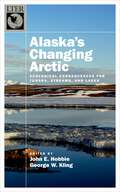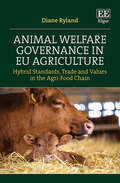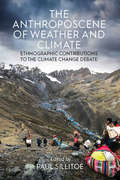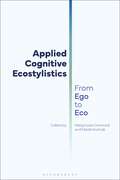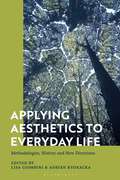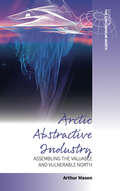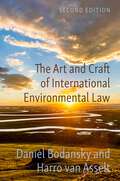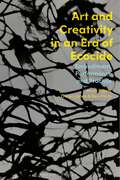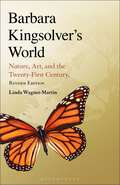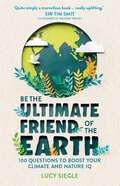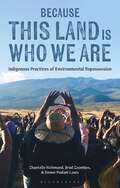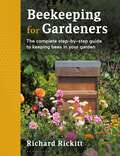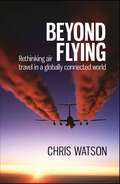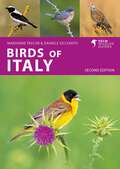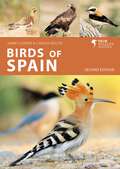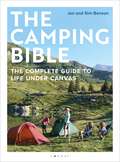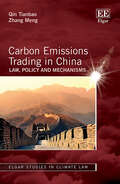- Table View
- List View
Alaska's Changing Arctic: Ecological Consequences For Tundra, Streams, And Lakes
by John E. Hobbie George W. KlingAnimal Welfare Governance in EU Agriculture: Hybrid Standards, Trade and Values in the Agri-Food Chain
by Diane RylandThis ground-breaking book sets out a comprehensive governance framework to raise the welfare of animals across EU agriculture and the agri-food chain. Diane Ryland argues that a global response is needed to promote animal wellbeing in agriculture, focusing on the importance of the relations between standard-setting bodies.Through a comparative analysis of major animal welfare standards, this book develops a transnational soft law hybrid governance model for animal welfare in agriculture. It examines, critically, animal welfare standards in the public and private spheres, investigating the links between the two and how they can be advanced. Drawing on extensive case studies, chapters explore animal welfare comprehensively for specific species and at various stages, in EU agriculture and the food supply chain. Ultimately, Ryland shows that concerned and informed consumers will be the drivers of change for effective global animal law.Animal Welfare Governance in EU Agriculture will be an invaluable resource for students and scholars in animal law, environmental law, regulation and governance, standardisation, and agricultural economics. It will also be an essential guide for activists and policymakers interested in improving the welfare of animals raised and traded in agriculture.
The Anthroposcene of Weather and Climate: Ethnographic Contributions to the Climate Change Debate
by Paul SillitoeWhile it is widely acknowledged that climate change is among the greatest global challenges of our times, it has local implications too. This volume forefronts these local issues, giving anthropology a voice in this great debate, which is otherwise dominated by natural scientists and policy makers. It shows what an ethnographic focus can offer in furthering our understanding of the lived realities of climate debates. Contributors from communities around the world discuss local knowledge of, and responses to, environmental changes that need to feature in scientifically framed policies regarding mitigation and adaptation measures if they are to be effective.
Applied Cognitive Ecostylistics: From Ego to Eco
This book offers an up-to-date account of one of the most influential strands of eco-research: cognitive ecostylistics. The onset of the 1970s saw a global shift in scholarly perspective upon the relation between egocentric and ecocentric views of the world. The so-called eco-turn was not only linguistic at its roots, but engaged the bulk of academic thought in social sciences and humanities. Cognitive ecostylistics invites a multidisciplinary approach to the study of the conceptual relations between oral or written texts and their impact on the environment. This volume is a collection of the latest research that seeks to apply the theory and methodology developed over the last 40 years to both literary and real-life texts, engaging with a wealth of examples from First World War poetry and Anne of Green Gables through to Condé Nast Traveller hotel descriptions. Exploring the cultural effects of the eco-turn, the collection engages the reader in the problem of the present-day Anthropocene, manifested as Ego-Eco tensions at the level of communicating self-needs and the needs of the Other. Divided into two parts, it considers first the human-angled semiotic interplay contained within the universe of people, before examining the problem of semiotic engagement of texts as extraneous to the human, highlighting crucial aspects of nature, culture, and beyond.
Applying Aesthetics to Everyday Life: Methodologies, History and New Directions
Applying Aesthetics to Everyday Life surveys current debates in the field of everyday aesthetics, examining its history, methodology and intersections with cognate research areas. Lisa Giombini and Adrián Kvokacka bring together an international team of renowned scholars who are shaping the present and future of the discipline. They demonstrate how the historical origins of everyday aesthetics emerges across the history of Western aesthetic thought, from Renaissance thinkers to the modern German philosophers Baumgarten, Kant and Heidegger. Chapters shed light on the field's methodological underpinnings, tracing its theoretical foundations back to epistemology and ethics and assess the potential of everyday aesthetics as a theoretical tool. They reveal its interdisciplinary nature and how it assists various fields of inquiry, including environmental and urban aesthetics, conservation ethics and the philosophy of art. Through fresh explorations of its origins, background and contemporary developments, this collection advances a new definition of everyday aesthetics and provides a cutting edge reflection on the world we inhabit today.
Arctic Abstractive Industry: Assembling the Valuable and Vulnerable North (Studies in the Circumpolar North #5)
by Arthur MasonThrough diverse engagements with natural resource extraction and ecological vulnerability in the contemporary Arctic, contributors to this volume apprehend Arctic resource regimes through the concept of abstraction. Abstraction refers to the creation of new material substances and cultural values by detaching parts from existing substances and values. The abstractive process differs from the activity of extractive industries by its focus on the conceptual resources that conceal processes of exploitation associated with extraction. The study of abstraction can thus help us attune to the formal operations that make appropriations of value possible while disclosing the politics of extraction and of its representation.
Are Trees Alive?
by Debbie S. Miller"Are trees alive? How do they breathe? They don't have noses." And so begins a conversation between the author and her daughter that leads to a remarkable discovery: Trees are like children in so many ways! They may look very different from people, but trees have roots that hold them to the ground like feet and leaves that blow in the wind like hair. Their bark even comes in different colors, just like our skin. From this poetic comparison of plants and humans, readers will learn how trees live and grow, and how they get their food. They will learn about the baobab trees of Africa, the banyan trees of India, and the bristlecone pines of California. They will see, through Stacey Schuett's exquisite art, that trees come in all shapes and sizes-just like people-and provide a home to many different animals. But most of all, they will look at trees with greater respect and a bit of awe, after realizing that trees are alive too.
The Art and Craft of International Environmental Law
by Daniel Bodansky Harro van AsseltIn countless ways we are affected by international environmental norms: some social, others legal; some quite general, others very specific. For example, the norms limiting the refrigerants used in air conditioners have been agreed upon in legal form internationally, and are mandated and enforced by national governments. The sustainable fishery and forestry standards used by Carrefour and Ikea were developed more informally by environmental groups and businesses, and are applied to producers through supply-chain contracts, without any government involvement. The reluctance to eat tuna fish or own elephant ivory reflects more general social norms, disseminated through education and culture. How and why do these norms arise? In what ways do they affect behavior? Do they change what states and individuals actually do and, if so, why? How effective are they in solving international environmental problems? In the second edition of The Art and Craft of International Environmental Law, Daniel Bodansky and Harro van Asselt explore these and other questions. Revisions cover the numerous developments spanning the 13 years since the first edition was published. New chapters address the growing role of environmental NGOs and the increasingly complex architecture of environmental law involving multiple institutions, levels of governance, and actors. Recent research has been incorporated on treaty design and policy implementation and effectiveness, and greater attention has been given to the role of the judiciary in standard-setting, implementation, and enforcement. A sophisticated yet highly readable introduction to how international environmental law works (and sometimes doesn't work), this book is essential reading for a wide audience.
Art and Creativity in an Era of Ecocide: Embodiment, Performance and Practice
What can creativity achieve in an era of ecocide? How are people using creative and artistic practices to engage with (and resist) the destruction of life on earth? What are the relationships between creativity and repair in the face of escalating global environmental crises? Across twelve compelling case studies, this book charts the emergence of diverse forms of artistic practice and brings together accounts of how artists, scholars and activists are creatively responding to environmental destruction.Highlighting alternative approaches to creativity in both conventional art settings and daily life, the book demonstrates the major influence that ecological thought has had on contemporary creative practices. These are often more concerned with subtle processes of feeling, experience and embodiment than they are with charismatic 'eco-art' works. In doing so, this exploratory book develops a conception of creativity as an anti-ecocide endeavour, and provides timely theoretical and practical insights on art in an age of environmental destruction.
Barbara Kingsolver's World: Nature, Art, and the Twenty-First Century, Revised Edition
by Prof Linda Wagner-MartinA revised edition of Linda Wagner-Martin's comprehensive study of the novels, stories, essays and poetry of American author Barbara Kingsolver. Now updated so that coverage runs from Kingsolver's first novel, The Bean Trees, through to her most recent, Demon Copperhead. Author of the only biography of Barbara Kingsolver and of a reader's guide to The Poisonwood Bible, Wagner-Martin has become the leading authority on this Pulitzer-prize-wining author. Here she covers every work in Kingsolver's oeuvre, emphasizing the writer's blend of the scientific method in which she was formally trained with her convincing understanding of the human characters that fill her books. What Kingsolver achieves throughout all her writing is a seamless blending of the various parts of human existence. She melds important themes through parts and pieces of the natural world-the African snakes, the Monarch butterflies, the coyotes in Deanna Wolfe's existence. Repeatedly Kingsolver writes to create both characters and the characters' worlds, bringing all these pieces into masterful, and whole, realities.This edition includes two new chapters - one on her 2018 novel, Unsheltered, and the second on her 2022 novel, Demon Copperhead - and is the first study of Kingsolver to publish since she was awarded the Pulitzer Prize for Fiction in 2023.
Be the Ultimate Friend of the Earth: 100 Questions to Boost Your Climate and Nature IQ
by Lucy Siegle‘This is a quite simply a marvellous book. I couldn’t find a trace of po-faced sanctimony nor yet the patronising tones of an expert attempting to speak to mortals. The conversational style – the beguiling marriage between accessible science and conspiratorial whispers which make it OK not to know everything – is really uplifting ... may everyone get the rush of pleasure from it that I have done.’ Sir Tim Smit, co-founder of the Eden Project'As someone who is passionate about nature and a proud eco nerd, I love this book and you will too!' Ellie Goulding, singer-songwriter and UN Environment Ambassador_______________________________________How much do you know about the state of our planet and the journey we’re on to reach a more sustainable future? Journalist and broadcaster Lucy Siegle tackles ten big topics involved in our quest to reach net zero and, through stories and revealing questions, probes your understanding of what we can all do to get there.Divided into ten important topics, and including revealing questions on recycling and reusing, the importance of flora and fauna and planet-friendly food, find out how much you really know about how our consumer habits and lifestyles are affecting the environment, and the positive changes we can make now to ensure we're all true friends of the earth. Packed full of stories and tips that show the people, the projects and the places that are already living as if this planet was precious, this is an essential handbook for anyone looking to improve their understanding of how we can all have a positive impact on Planet Earth.
Because This Land is Who We Are: Indigenous Practices of Environmental Repossession
by Chantelle RichmondBecause This Land Is Who We Are is an exploration of environmental repossession, told through a collaborative case study approach, and engaging with Indigenous communities in Canada (Anishinaabe), Hawai'i (Kanaka Maoli) and Aotearoa (Maori). The co-authors are all Indigenous scholars, community leaders and activists who are actively engaged in the movements underway in these locations, and able to describe the unique and common strategies of repossession practices taking place in each community. This open access book celebrates Indigenous ways of knowing, relating to and honouring the land, and the authors' contributions emphasize the efforts taking place in their own Indigenous land. Through engagement with these varying cultural imperatives, the wider goal of Because This Land Is Who We Are is to broaden both theoretical and applied concepts of environmental repossession, and to empower any Indigenous community around the world which is struggling to assert its rights to land.The ebook editions of this book are available open access under a CC BY-NC-ND 4.0 licence on bloomsburycollections.com. Open access was funded by Knowledge Unlatched.
Beekeeping for Gardeners: The complete step-by-step guide to keeping bees in your garden
by Richard RickittA comprehensive gardener's guide to sustainable beekeeping.Beekeeping has changed. While once it was a hobby that pursued the rich rewards of honey and wax, many new beekeepers now instead seek the gratification of knowing that they are aiding the survival of one of the world's most important creatures. Keeping bees today is as much about providing the right habitats and resources to help pollinators thrive as it is about chasing every drop of golden honey.This beautifully illustrated guide to the ancient hobby of beekeeping shows today's gardeners how to create beautiful gardens that are richly rewarding for people and bees alike. Flowers, shrubs, trees and vegetable plots can provide colourful beauty and delicious produce as well as vital pollen and nectar when bees need it the most. There are lists of the top-performing plants and how and where to grow them, including window boxes, lawns, borders, wild gardens and even ponds.Beekeeping for Gardeners looks at the pleasures and benefits of keeping honey bees in gardens of all types and sizes, both rural and urban. It explains the practicalities involved in keeping bees in the domestic garden setting, as well as on rooftops, allotments, parks, farmland and other locations. Importantly, and unlike any book before, this guide sets the delightful hobby of beekeeping within the context of the wider environment, asking how it can best serve the needs of all types of pollinator and the local ecology in general.Whether you're looking to attract more bumblebees and solitary bees or want to install a beehive, this wonderful book contains all the guidance you'll need to have a garden buzzing with bees.
Before Environmental Law: A History of a Vanishing Continent
by Professor Benjamin J RichardsonThis landmark book unveils the history of defending Australia's natural environment and examines the subject's legal and political contexts from the birth of the nation in 1901 until the advent of the so-called modern era of environmental regulation in the late 1960s. It rejects the mythology that Australia lacked environmental law before the late 1960s in revealing how many of today's environmental laws, from pollution control to nature conservation, emerged from precedents or events much earlier in the 20th century. This history however reveals a discrepancy between lawmakers' greater efficacy to exploit rather than protect the environment, a discrepancy that grew as nature's backlash intensified in a rapidly degrading continent colonised to build the Australian nation. In exploring these dynamics, the book offers a rich tapestry of case studies illustrated with historic photographs that show the origins of Australia's environmental laws and how they borrowed from international precedents or furnished lessons for other nations. Through its multi-disciplinary enquiry, the book offers scholars and students of environmental law, legal history and the environmental humanities a unique story about the failures and successes in the making of environmental law.
Beyond Flying: Rethinking air travel in a globally connected world
by Chris WatsonIs flying an irreplaceable part of 21st-century life? Can businesses succeed in a globalised world without international air travel? What about 'love miles' – visiting friends and family overseas?Architect and writer Chris Watson grew up in an airline family, passionate about aviation and how it allows us to explore the world, share knowledge and create more diverse communities. But this freedom has come at a cost for the environment. Aviation is a significant factor in climate change - and one that's been steadily growing in both developed and undeveloped countries, burning fossil fuels and emitting harmful greenhouse gases. Flying is never zero-carbon, so can we reduce it, or even do without it? Fourteen remarkable travellers from around the world share their stories with Chris about how they came to the conclusion that reducing their air travel was necessary to lower their personal emissions. From backgrounds as diverse as commercial, professional, academic, NGOs, literature and science, they have found easy and better ways of living and working, saving what few flights they do take for emergencies and 'love miles'. Their stories look at how our modern, globalised world offers more alternatives to keep in touch with people around the world without contributing to the aviation industry's ever-increasing emissions. Filled with success stories and practical guidance to help people make more informed decisions, this book is a must-read for any frequent flyer - or for anyone involved in a global business. Beyond Flying demonstrates that even the toughest of environmental challenges can be addressed.
Birds and Bees, Sharp Eyes and Other Papers
by John BurroughsFrom the Biographical Sketch:<P> "Probably no other American writer has a greater sympathy with, and a keener enjoyment of, country life in all its phases--farming, camping, fishing, walking--than has John Burroughs. His books are redolent of the soil, and have such "freshness and primal sweetness," that we need not be told that the pleasure he gets from his walks and excursions is by no means over when he steps inside his doors again. As he tells us on more than one occasion, he finds he can get much more out of his outdoor experiences by thinking them over, and writing them out afterwards."<P> Mary E. Burt
Birds of Italy: Second Edition (Helm Wildlife Guides)
by Daniele Occhiato Ms Marianne TaylorThe definitive photographic guide to the amazing avifauna of Italy.From the Alps and Dolomites in the north to the coastlines of the Mediterranean Sea, Italy has a diverse range of natural habitats. The country is also a migration path across Europe and Africa, making it an exciting place to spot both endemic and migrant birds.This fully revised and updated guide to the birds of Italy by naturalist Marianne Taylor and Italian photographer Daniele Occhiato covers more than 320 birds most likely to be seen on any visit to the country. Portable and reliable, the concise text for each species includes information on identification, songs and calls, behaviour, distribution, and habitat, with each photo carefully selected to aid identification. A guide to the best birdwatching sites in Italy is also included. This is the perfect guide for travellers and birdwatchers visiting this spectacular and bird-rich country in southern Europe.
Birds of Spain: Second Edition (Helm Wildlife Guides)
by James Lowen Carlos Bocos GonzalezThe definitive photographic guide to the avifauna of Spain. Spain is recognised as one of Europe's richest birdwatching destinations, one that offers a host of regional specialities. It includes famous birding hotspots such as the vast Coto Doñana wetlands, mountainous areas such as the Pyrenees and Picos de Europa, the Mediterranean oak forests of the south, the migration crossroads of the Strait of Gibraltar and the plains of Extremadura. Completely revised and updated, this new version of Birds of Spain provides photographic coverage of more than 320 species that regularly occur in the region, from the Hoopoe to the Golden Eagle. Concise text for each species includes information on identification, songs and calls, behaviour, distribution and habitat, with each photo having been carefully selected to aid identification. A guide to the best birdwatching sites in Spain is also included.Portable yet authoritative, this is the perfect companion for any wildlife-friendly visitor to this spectacular and bird-rich country.
The Camping Bible: The Complete Guide to Life Under Canvas
by Jen Benson Sim BensonSlow down. Simplify. Sleep with your ear to the earth. This is the ultimate guide to the art and joy of living outdoors, under canvas. Whether it's a fast-and-light backpacking adventure, a sea kayak safari, a family camping trip, or simply living and cooking outside in your garden, camping can do it all. Offering an escape from the stresses of everyday life, the art of camping lies in living simply, well. It's about paring back our busy, hyperconnected modern lives and embracing the many joys of living more slowly and connecting more meaningfully.The Camping Bible is the complete reference for newcomers and lifelong campers alike. Discover new adventures and clever hacks for Proper Camping, sleeping close to the earth in a shelter of stretched fabric held taught by pegs and guy lines, surrounded by the sounds of nature.It includes:- a complete introduction for beginners: tent selection; pitching tips; setting up portable kitchens- family-friendly advice: making the tent a home; entertaining kids in bad weather- glamping with bell tents and tipis: how to create a luxurious experience- ideas and advice for seasoned campers: 'The Art of the Tarp', camp cookery; sustainabilityWritten by passionate and highly experienced outdoor experts, The Camping Bible is packed with wisdom, step-by-step instructions, tried-and-tested advice, top tips, recommended gear, adventure ideas, and beautiful photography and illustrations.
Carbon Emissions Trading in China: Law, Policy and Mechanisms (Elgar Studies in Climate Law)
by Qin Tianbao Zhang MengEmissions Trading Systems (ETS) have been hailed as a game changer for the evolving climate crisis. This book provides an in-depth analysis of China’s carbon ETS, including its legal and policy frameworks, carbon market mechanisms, and international and comparative implications.With nine cutting-edge topics divided into three thematic parts, this comprehensive book probes the essential concepts, contemporary research, and key elements of carbon emissions trading in China. Multidisciplinary in scope, the book draws on insights from law, policy, economics, environmental management, and geopolitics, to provide a comprehensive and nuanced analysis of the development of carbon emissions trading in China. Placing China’s carbon ETS within the broader context of international efforts to address climate change, it provides a comparative perspective with international value.This book will be an essential resource for scholars and researchers of international and comparative climate law and policy, environmental management, economics, and climate politics. It will prove an indispensable guide for students of Chinese law, climate law, environmental policy, and comparative environmental law. Practitioners, policymakers, and government officials working in climate governance seeking the state-of-the-art of the development of ETS in China will also benefit greatly from its insights.

